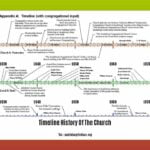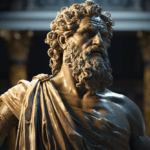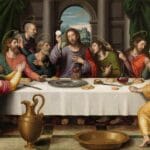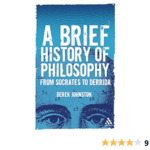Brace yourselves for a thought-provoking journey through the annals of Christianity’s foundational years in our article titled “[Unveiling the Early Church History Timeline: A Journey Through the Foundation Era of Christianity].” Embark on an exploration of the pivotal events, influential figures, and profound theological developments that shaped the early church, laying the groundwork for its enduring legacy.
Key Takeaways:
- The Early Church History Timeline spans the first four centuries of Christianity.
- St. Benedict founded the influential Benedictine Order in 529.
- The Arian Controversy resulted in the Council of Nicea in 325, establishing the doctrine of the Trinity.
- The Octavius Debate defended Christianity against paganism and remains an important early Christian text.
- In addition to the Bible, other documents and writings were considered inspired in the early church.
Early Church History Timeline
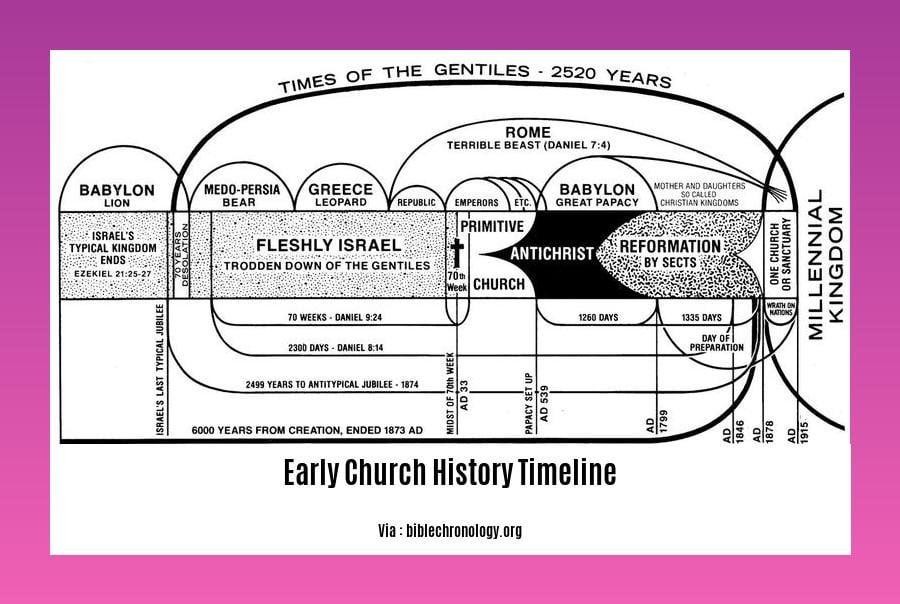
Embarking on a journey through the early church history timeline is like delving into a treasure trove of ancient wisdom, spiritual struggles, and profound historical significance. From humble beginnings to its remarkable spread throughout the Roman Empire, the early church’s narrative is a tapestry of faith, perseverance, and transformation. Let’s explore some key highlights of this fascinating era:
The Apostolic Era (30-100 AD)
- Following the crucifixion and resurrection of Jesus Christ, his disciples, known as the apostles, played a pivotal role in spreading his teachings.
- Peter, widely regarded as the first pope, established the church in Rome.
- Paul, a former persecutor of Christians, became a fervent advocate for the faith, undertaking missionary journeys throughout the Roman Empire.
- The apostles faced persecution and martyrdom, yet their unwavering commitment laid the foundation for the Christian church.
The Post-Apostolic Era (100-313 AD)
- The church continued to grow despite facing opposition from both Roman authorities and Jewish leaders.
- Influential Christian thinkers, such as Justin Martyr and Origen, defended the faith intellectually.
- Christian communities flourished in urban centers, forming a network of believers across the empire.
The Imperial Church (313-600 AD)
- Emperor Constantine’s conversion to Christianity in 312 AD marked a turning point for the church.
- The Edict of Milan in 313 AD granted religious freedom to Christians, ending centuries of persecution.
- The church became an integral part of the Roman Empire, influencing politics, culture, and society.
- Significant theological controversies, such as the Arian Controversy, shaped the development of Christian doctrine.
Key Figures of the Early Church
| Figure | Role | Significance |
|---|---|---|
| Peter | Apostle, first pope | Founded the church in Rome, spread Christianity throughout the Roman Empire. |
| Paul | Apostle, missionary | Prolific writer, established Christian communities across the empire, faced persecution. |
| Justin Martyr | Christian apologist | Defended Christianity against pagan criticism, wrote influential works. |
| Origen | Christian theologian, scholar | Prolific writer, influential in the development of Christian thought. |
| Constantine | Roman emperor | Converted to Christianity, issued the Edict of Milan, legalized Christianity. |
The Legacy of the Early Church
The early church history timeline left an indelible mark on Christianity and Western civilization as a whole. Some of its enduring legacies include:
- The establishment of the Christian church as a major religious force.
- The development of Christian theology and doctrine.
- The preservation of ancient Christian writings, including the New Testament.
- The spread of Christianity throughout the Roman Empire and beyond.
As we reflect on the early church history timeline, we gain a deeper appreciation for the remarkable journey that Christianity has undertaken. It is a story of faith, resilience, and the enduring power of belief.
To gain significant insights into the political, social, and economic developments of modern India, dive into the captivating chronology of modern Indian history. Discover how fashion evolved through the ages in India, from traditional attire to contemporary trends, by delving into the clothing in India history. Lastly, immerse yourself in the intriguing journey of dance in India, from its ancient origins to the dynamic expressions of contemporary dance history.
Major Theological Developments: Defining Christian Beliefs
A transformative era in the evolution of Christianity, the early church laid the foundation for its rich tapestry of beliefs and practices. Emerging from the Jewish community, it harnessed Greek thought to shape its doctrine, blending biblical teachings with the philosophical framework of its time.
Key Developments
-
Doctrine Establishment: The early church developed its distinctive theology through a process of scriptural interpretation, theological reflection, and debates with opposing viewpoints.
-
Council Impact: Church councils, such as the Council of Nicaea in 325 AD, played a pivotal role in defining Christian doctrine, addressing heresies, and establishing the Nicene Creed.
-
Apostles Influence: Apostles, like Peter and Paul, played a crucial role in spreading the teachings of Jesus and establishing early Christian communities.
Heretical Challenges
-
Gnosticism: Gnostics believed in a spiritual, hidden knowledge that led to salvation, often emphasizing the superiority of spirit over matter.
-
Arianism: Arius, a priest from Alexandria, challenged the divinity of Jesus, stating that Jesus was a created being, not equal to God the Father.
-
Donatism: Followers of Donatus believed that the sacraments were invalid if administered by priests who had compromised their faith during persecution.
Theological Defenders
-
Justin Martyr: A Christian philosopher, Justin defended the faith against pagan accusations, arguing for the reasonableness of Christianity and its superiority to paganism.
-
Origen: An influential theologian, Origen developed the concept of allegorical interpretation of Scripture, seeing multiple layers of meaning within biblical texts.
-
Augustine: A prolific writer and theologian, Augustine’s writings on grace, free will, and the nature of sin profoundly shaped Christian thought.
Key Takeaways:
-
Early Christianity shaped its doctrine by interpreting Scripture, engaging in theological reflection, and confronting heresies.
-
The early church used Greek philosophical ideas to help explain and spread Christian teachings.
-
Early church councils, like Nicaea, were crucial in establishing Christian doctrine and addressing heretical challenges.
-
Heretical movements, such as Gnosticism, Arianism, and Donatism, challenged early Christian beliefs and practices.
-
Christian thinkers like Justin Martyr, Origen, and Augustine defended the faith and developed influential theological ideas.
Sources:
The Development of Christian Doctrine
Major Theological Developments in the Early Church
Apostles and Missionaries: Spreading the Gospel
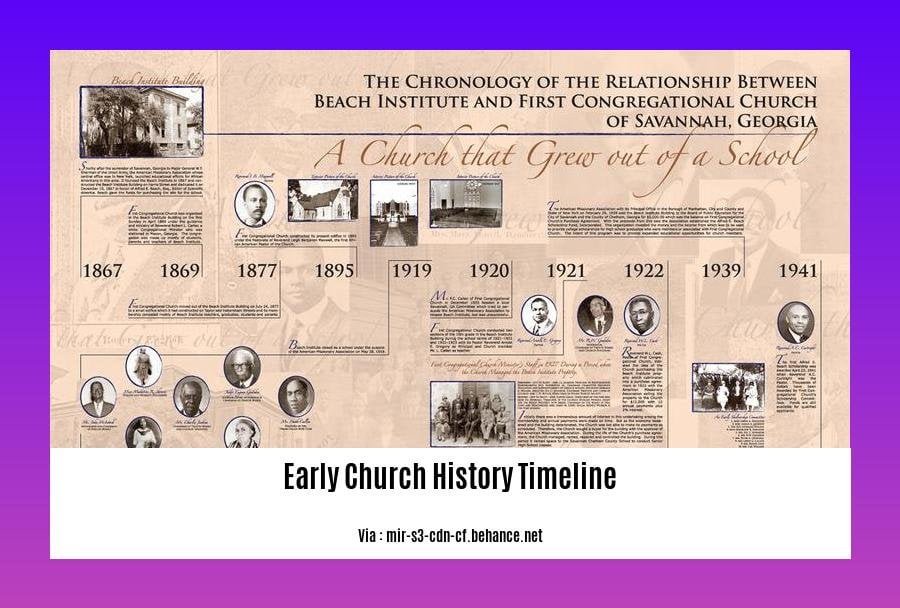
The early church was built on the tireless efforts of Apostles and Missionaries who dedicated their lives to spreading the teachings of Jesus Christ. These individuals played a pivotal role in shaping the foundation of Christianity, carrying the gospel message to far-flung corners of the Roman Empire and beyond.
Spreading the Gospel: A Divine Mission
Driven by unwavering faith and divine inspiration, the Apostles and Missionaries embarked on a mission to spread the gospel message to all corners of the known world. Their journeys took them across treacherous terrains, tumultuous waters, and into the heart of hostile territories. Their zeal and commitment were fueled by the profound belief in the transformative power of Jesus’ teachings.
The Apostles: Cornerstones of the Early Church
The Apostles, chosen by Jesus himself, held a special place in the early church. These twelve individuals, led by Peter, formed the backbone of the church’s foundation. They were entrusted with the responsibility of spreading the gospel and establishing Christian communities throughout the Roman Empire.
-
Peter, known as “the Rock,” was instrumental in establishing the church in Rome, which would later become the center of Christianity.
-
Paul, initially a persecutor of the early church, experienced a life-changing encounter with Jesus and became one of the most prolific missionaries, spreading the gospel to various regions, including Greece, Asia Minor, and Rome.
Missionaries: Extending the Reach of Christianity
Beyond the Apostles, countless missionaries played a vital role in expanding the reach of Christianity. These dedicated individuals, motivated by a deep desire to share the gospel, ventured into uncharted territories, facing numerous challenges and persecutions.
-
Early Jewish Missionaries: The first Christian missionaries were Jewish and took Jesus’ teachings to the synagogues, reaching out to their fellow Jews and establishing Christian communities within the Jewish diaspora.
-
Paul’s Missionary Journeys: Paul’s missionary journeys, chronicled in the book of Acts, were pivotal in spreading the gospel beyond Jewish communities to the Gentile world. His tireless travels and teachings laid the groundwork for the establishment of Christian communities throughout the Roman Empire.
-
Persecution and Triumph: Despite facing fierce opposition and persecution from both Jewish and Roman authorities, the early missionaries persevered. Their unwavering faith and determination in the face of adversity served as a testament to the strength of their convictions and the transformative power of the gospel message.
Key Takeaways:
-
Apostles and Missionaries played a crucial role in spreading the gospel message beyond the boundaries of Judea.
-
The Apostles, chosen by Jesus, were instrumental in establishing the foundation of the early church.
-
Peter played a pivotal role in establishing the church in Rome, while Paul spread the gospel to various regions, including Greece, Asia Minor, and Rome.
-
Missionaries ventured into uncharted territories, spreading the gospel to both Jews and Gentiles.
-
Despite facing opposition and persecution, the Apostles and Missionaries persevered, laying the groundwork for the expansion of Christianity throughout the Roman Empire.
Sources:
The Rise of Church Hierarchy: Establishing Structures
In the earliest days of Christianity, there was no formal hierarchy. Everyone was equal in the eyes of God, and there was no distinction between clergy and laity. It was all about the amazing grace of God. However, as the church grew rapidly, leaders emerged naturally. They were often the most gifted in teaching, preaching, and guiding the community. These leaders were called elders (also known as presbyters or bishops), and they were responsible for overseeing the spiritual and practical needs of the church.
Key Takeaways:
-
The early church was egalitarian with no formal hierarchy.
-
Leaders (elders, presbyters, or bishops) emerged to meet the spiritual and practical needs of the growing church.
-
The threefold ministry of bishops, presbyters, and deacons developed over time to meet the needs of the growing church.
-
The church’s structure and hierarchy were influenced by both Jewish and Roman traditions.
-
The rise of the church hierarchy helped to maintain order and unity within the church.
Gradually, a threefold ministry developed, consisting of bishops, presbyters, and deacons. Bishops were responsible for overseeing a group of churches in a particular area. Presbyters (also known as elders) were responsible for the spiritual care of a local church. Deacons were responsible for the practical needs of the church, such as distributing food and clothing to the poor.
The structure of the early church was influenced by both Jewish and Roman traditions. In Jewish synagogues, there was a council of elders who oversaw the affairs of the community. In the Roman Empire, there was a hierarchy of officials who administered the government. The early church adopted elements from both of these traditions to create its own unique structure.
The rise of the church hierarchy helped to maintain order and unity within the church. As the church grew larger, it became more difficult to manage without a clear structure. The hierarchy provided a way to delegate responsibilities and to ensure that everyone was working together towards a common goal.
Of course, the rise of the church hierarchy was not without its challenges. One challenge was the potential for abuse of power. Some clergy members became arrogant and corrupt, and they used their position to lord over the people instead of serving them. Another challenge was the potential for division. When there is a hierarchy, there is always the possibility that people will disagree about who should be in charge.
Despite these challenges, the rise of the church hierarchy was a necessary step in the development of the church. It provided a way to maintain order and unity, and it helped to ensure that the church could continue to grow and spread the gospel.
Relevant URL Sources:
- The History of Church Hierarchy
- The Development of Church Structure
FAQ
Q1: What factors contributed to the development of the early church’s organization and structure?
A1: The early church’s organization developed in response to both internal and external pressures. It gradually adopted a hierarchical structure with bishops, priests, and deacons, influenced by Jewish and Roman models of leadership.
Q2: How did the growth of the early church impact its organizational structure?
A2: Periods of peace and stability allowed the early church to grow and become more organized. The influx of new members led to the establishment of new congregations or communities, each headed by a bishop.
Q3: What challenges and persecutions did the early church face during its formative period?
A3: The early church endured various challenges, including persecution from Roman emperors like Nero and Diocletian. It faced accusations and criticism from both Jewish and pagan communities, as well as internal struggles with heresies and controversies.
Q4: How did the conversion of Constantine I impact the early church’s development?
A4: The conversion of Constantine I in the 4th century marked a significant turning point for the early church. It led to the legalization of Christianity in the Roman Empire, granting the church official recognition and protection. This enabled the church to construct churches, spread more freely, and gain greater influence within the Roman society.
Q5: What significant events and figures shaped the early church’s doctrine and beliefs?
A5: The early church’s doctrine and beliefs were shaped by numerous events and influential figures. Key events included the Council of Nicea in 325, which established the doctrine of the Trinity, and the writings of early Church Fathers such as Augustine of Hippo, Tertullian, and Origen, who contributed to the development of Christian theology and dogma.
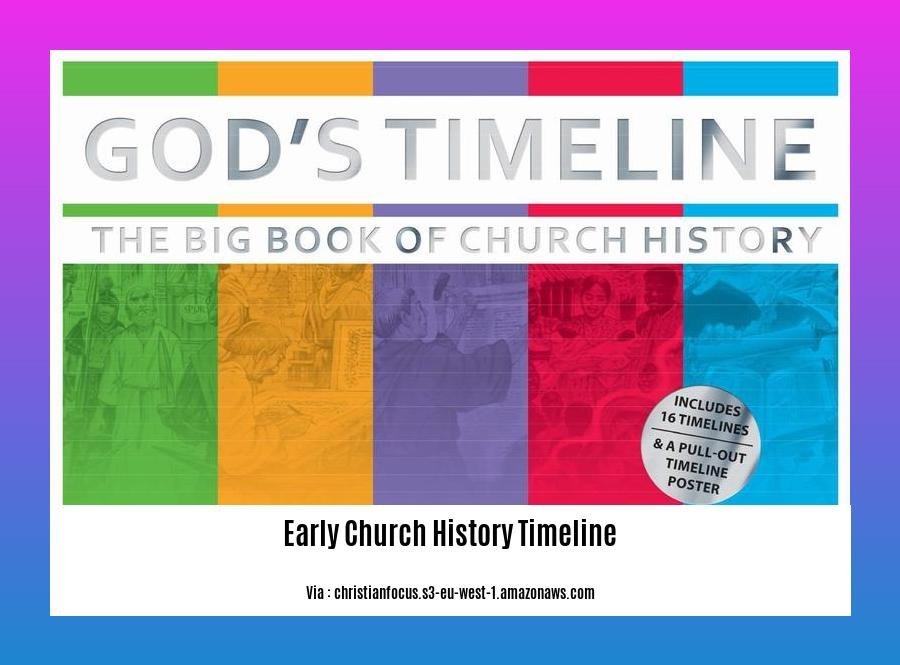
![A Historical Overview of the Church: Tracing Its Evolution Through the Ages [History of the Church Summary] history-of-the-church-summary_2](https://www.lolaapp.com/wp-content/uploads/2023/12/history-of-the-church-summary_2-150x150.jpg)
